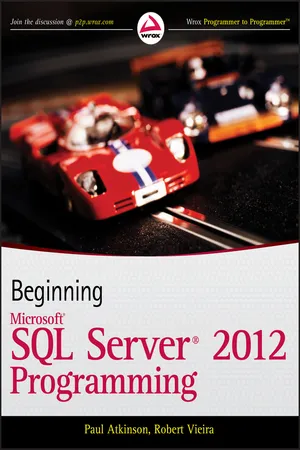Computer Science
SQL Trigger Update
An SQL trigger update is a database object that automatically executes a set of SQL statements when a specific event occurs, such as an update to a table. It can be used to enforce business rules, maintain data integrity, and automate tasks.
Written by Perlego with AI-assistance
Related key terms
4 Key excerpts on "SQL Trigger Update"
- eBook - ePub
- Paul Atkinson, Robert Vieira(Authors)
- 2012(Publication Date)
- Wrox(Publisher)
so many SQL Server people I meet are) with the distorted notion that triggers are evil and should never be used. Neither will you side with at the other end of the spectrum, who think that triggers are the solution to all the world’s problems. The right answer in this respect is that triggers can do a lot for you, but they can also cause a lot of problems. The trick is to use them when they are the right things to use, and not to use them when they aren’t.Some common uses of triggers include:- Enforcing referential integrity: Although I recommend using Declarative Referential Integrity (DRI) whenever possible, there are many things that DRI won’t do (for example, referential integrity across databases or even servers, many complex types of relationships, and so on).
- Creating audit trails: This means writing out records that keep track of not just the most current data, but also the actual change history for each record. This may eventually become less popular with the change-data tracking that SQL Server 2008 added, but triggers are still a pretty popular choice.
- Creating functionality similar to a CHECK constraint: Unlike CHECK constraints, this can work across tables, databases, or even servers.
- Substituting your own statements in the place of a user’s action statement: This is typically used to enable inserts in complex views.
WHAT IS A TRIGGER?
A trigger is a special kind of stored procedure that fires in response to specific events. There are two kinds of triggers: Data Definition Language (DDL) triggers and Data Manipulation Language (DML) triggers.DDL triggers fire in response to someone changing the structure of your database in some way (CREATE , ALTER , DROP - Robert Vieira(Author)
- 2010(Publication Date)
- Wrox(Publisher)
And these are just a few. So, with no further ado, let's look at exactly what a trigger is. What Is a Trigger?A trigger is a special kind of stored procedure that responds to specific events. There are two kinds of triggers: Data Definition Language (DDL) triggers and Data Manipulation Language (DML) triggers.DDL triggers fire in response to someone changing the structure of your database in some way (CREATE , ALTER , DROP , and similar statements). These were first added back in SQL Server 2005 and are critical to some installations (particularly high-security installations) but are pretty narrow in use. In general, you will need to look into using these only where you need extreme auditing of changes/history of your database structure. We will save these until last.DML triggers are pieces of code that you attach to a particular table or view. Unlike sprocs, where you needed to explicitly invoke the code, the code in triggers is automatically run whenever the event(s) you attached the trigger to occurs in the table. Indeed, you can't explicitly invoke triggers—the only way to do this is by performing the required action in the table that they are assigned to.Beyond not being able to explicitly invoke a trigger, you'll find two other things that exist for sprocs but are missing from triggers: parameters and return codes.While triggers take no parameters, they do have a mechanism for figuring out what records they are supposed to act on (we'll investigate this further later in the chapter). And, while you can use the RETURN keyword, you cannot return a specific return code (because you didn't explicitly call the trigger, what would you return a return code to?).What events can you attach triggers to? The three “action” query types you use in SQL. So, you wind up with triggers based in inserts, updates, and/or deletes (you can mix and match to what events you want the trigger to be attached).- eBook - ePub
PostgreSQL 11 Server Side Programming Quick Start Guide
Effective database programming and interaction
- Luca Ferrari(Author)
- 2018(Publication Date)
- Packt Publishing(Publisher)
Triggers
Triggers are a powerful way to react to database events. Each time a new tuple is added to a table, a trigger can fire in order to perform some kind of data validation or propagation, or, in general, apply business rules. Triggers are nowadays a fundamental part of any DBMS system, and provide an infrastructure that helps the administrator to enforce data validation and constraints.The main idea behind a trigger is that when a specific event happens (such as some data changing), a trigger is fired and a specific piece of executable code runs. PostgreSQL implements triggers by means of functions, so the executable code of a trigger must be implemented as a FUNCTION. As we will see, this function must have a particular prototype and it must be able to access a set of pre-defined variables that keep information about what fired the trigger.PostgreSQL provides two main type of triggers, which are fired in reaction to either data manipulation or data definition. This chapter focuses on the powerful trigger infrastructure that PostgreSQL provides.This chapter will go through the following concepts:- Data manipulation triggers, the most common implementation of triggers, used to validate and propagate data
- Data definition triggers, a database-wide set of triggers that can intercept DDL statements, allowing you to audit and monitor database DDL activity
- Implementing trigger behavior in foreign languages, such as Perl and Java
Passage contains an image
Data manipulation triggers
A data manipulation trigger (DML trigger), is a trigger that fires in response to a DML statement (such as INSERT, UPDATE, DELETE, or TRUNCATE) that is executed against a particular table. DML triggers are defined by means of the following: - eBook - ePub
- Thomas Pettit, Scott Cosentino(Authors)
- 2022(Publication Date)
- Packt Publishing(Publisher)
A trigger runs automatically when a predefined action is performed on the table. You should use triggers when data has changed in a database and you want to take action. There are two types of triggers in MySQL. The first is called a row-level trigger, which executes once for each row in the transaction. The second is called a statement-level trigger, which executes only once for each transaction.There are three possible EVENTS a trigger can be assigned to – INSERT , UPDATE , and DELETE . A trigger can be run at a specific time concerning the event. The time can be either before or after the event occurs. A trigger can be used to validate data, log the old and new values in an audit trail, or ensure business rules are adhered to.You can create a trigger using the following syntax: CREATE TRIGGER trigger_name (AFTER|BEFORE) (INSERT|UPDATE|DELETE) ON table_name FOR EACH ROW BEGIN SQL to execute END Let's look at various aspects of triggers.Advantages of triggers
Triggers assist with data integrity, catching errors, and tasks that can be run automatically when the trigger fires rather than being scheduled. They are good for auditing data changes, logging events, and assisting in preventing invalid transactions.Disadvantages of triggers
Triggers cannot replace all data validation procedures. They can only provide additional data validation. They cannot be seen by the client applications and their actions can be confusing to developers as they cannot see what is happening in the database layer. They use a large number of resources on the database server and do not provide any benefits when there are a lot of data events per second. This is because the triggers will be firing all the time and drain the database server's resources.Restrictions with triggers
Triggers come with their own set of restrictions. For example, there can only be one trigger per event; you can only have one BEFORE UPDATE trigger on any given table but you can run several statements in them. Triggers do not return values. They cannot use the CALL
Learn about this page
Index pages curate the most relevant extracts from our library of academic textbooks. They’ve been created using an in-house natural language model (NLM), each adding context and meaning to key research topics.



